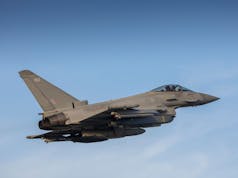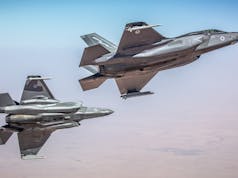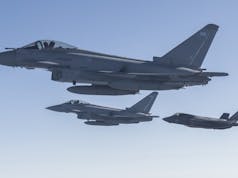The United States Air Force has awarded a contract worth up to $3.5 billion to Raytheon for the continued production of Advanced Medium Range Air-to-Air Missiles (AMRAAM), according to a U.S. Department of Defense announcement.
The deal covers production Lots 39 and 40 and includes missiles, telemetry systems, spares, and engineering support. Work will take place in Tucson, Arizona, with completion expected by the third quarter of fiscal year 2031.
According to the Pentagon, the contract involves Foreign Military Sales to a wide range of allies and partners, including the United Kingdom, Australia, Denmark, Japan, Sweden, Germany, Poland, and Ukraine, among others.
“Raytheon, Division of Raytheon Technologies Corp., Tucson, Arizona, was awarded a not-to-exceed $3,500,000,000 firm-fixed-price incentive, undefinitized contract action for Advanced Medium Range Air-to-Air Missile (AMRAAM) Production Lots 39 and 40. This contract provides for the production of AMRAAM missiles, AMRAAM Telemetry System, initial and field spares, and other production engineering support activities. This contract involves Foreign Military Sales (FMS) to: Denmark, Belgium, Japan, Netherlands, Canada, Finland, Germany, Hungary, Spain, Poland, Sweden, Taiwan, Lithuania, the United Kingdom, Australia, Switzerland, Ukraine, Isreal, and Kuwait.”
The contract was awarded on a sole-source basis, with funds drawn from a variety of US Navy and Air Force procurement and maintenance budgets, alongside over $621 million in foreign funding from participating governments.
The AMRAAM, first fielded in 1991, has become the standard medium-range air-to-air missile for many NATO and allied air forces. It has been used in multiple conflicts including the Gulf War, Kosovo, Syria, Ukraine, and Yemen. Manufactured by Raytheon, the missile has undergone several upgrades, with the current AIM-120D variant offering a range of up to 160 km and speeds exceeding Mach 4.
Guided by a combination of inertial navigation and active radar homing, AMRAAM is designed to operate in all weather and beyond-visual-range engagements. Its electronic architecture also allows mid-course updates from the launch platform. Recent versions incorporate improved seekers, propulsion, and software, enhancing effectiveness in contested environments.
AMRAAM is integrated across a wide array of Western fighter aircraft, including the F-35, F-15, F-16, F/A-18, Typhoon, and Gripen, and is also used in surface-launched air defence systems such as NASAMS.
The missile weighs around 161 kg and carries a 20 kg high-explosive fragmentation warhead. Depending on the variant, its range spans from 75 km to over 150 km.














For F-35B? Seeing as it won’t see Meteor anytime soon?
Yes, UK has always used the AMRAAM in the F-35s.
One of its few current weapons indeed.
And still (alongside ASRAAM) one of the best it could have.
! Really?? Only in as much as the US has blocked UK weapons integration to F35
Only because the US has blocked METEOR integration to F35. METEOR is in service with many other aircraft. However the US strategy is to block METEOR integration until a US competitive missile is integrated and serving on F35. This will be AIM260 which is not even in production yet. So METEOR integration gos back to 2035 – some say 2038, at least until it’s not seen as a threat to US missile exporters marketing plans
Enough with your ridiculous Russian conspiracy theories.
All new weapons (over 70), including American built ones, are being held up by Lockheed Martin’s difficulties in producing the upgrades necessary for the F35 to support these. Meteor integration is not the only delayed weapon, though certainly the most frustrating for the U.K.
He is right. Anything that challenges the US MIC is seen as a threat to sales. Not rocket science is it?
It would be difficult producing upgrades to support those weapons when AIM260 is the sole focus
So in that case then Meteor will be integrated to F35 before AIM260 – as it is way behind contract and years late?
Or shock horror will AIM260 be integrated before Meteor?
Which do you think is being held up the the longest?
This is a perfect example of how misinformation is spread online by people have no idea what they are talking about. It’s is obvious to anyone who wasn’t too lazy to look that there are significant integration issues that will need to be overcome, including UK actually providing the funds necessary. There are literally dozens of other weapons that are experiencing integration delays including significant US weapons due to LM being years behind schedule. Also For the Nth time, the JATM (AIM260) is a US special access program(SAP) which means they have no intention of selling it to anybody any time soon. Seriously there is loads of things you can find wrong about the US MIC without resorting to making things up.
Time will tell
Why insist on weapons integration for world-leading munitions, when you can just mass-buy the old American-made ones?
Exceptional.
Do you reckon there’s an “E” version in the works for bit of extra range and speed? Talking of Meteor didn’t France and the UK recently sign up for a successor or iteration to the Meteor? And if this is compatible with NASAM’s will the UK look at that system as part of its GBAD?
Doubt it. USN already has the AIM-174 in service and is rolling it out as fast as they can, and the USAF is working on the AIM-260.
AIM-174 weighs about five times as much as an AIM-120 AMRAAM though, so won’t be a like for like replacement but both will complement each other. The main objective of the AIM-174 is to provide an ability to hold off long-range Chinese air launched ASMs from attacking carrier groups i.e. to shoot down the attacking aircraft before it gets within launch range.
AIM-260 is still in development (although nearing production I believe), but still unclear whether it would replace or complement AMRAAM.
The US has already tacitly admitted that AIM260 – although not in series production or service will be integrated to F35 BEFORE METEOR – this is pure marketing rigging / domination by the US and will result in the destruction of European manufacturing unless UK & European governments wise up & man up.
Who is the biggest customer of the F35? The USA, so it’s requests are the highest priority. Like Meteor, the AIM-260, is held up LM’s delays with the Block 4 upgrade.
Why don’t you do a little research before posting conspiracy theories?
I suspect this is much more likely the truth, along with the UK not actually putting up the cash to pay for the prioritisation of the integration. It also suits the MOD/government not to do so, as it gives a ready made excuse for the slow buy rate of the jets themselves.
Plus slow buy rate is a circluar problem, LM won’t priorities the UK if it doesn’t place orders, resulting in an excuse not to place the orders. The original 138 figure has been quietly dropped further not helping.
Having worked in Ground to air and Air to Air missile development and fighter development for over 45 years am I not entitled to an opinion. My opinions are largely formed from bitter experience working with US defense contractors their DOD and Government. One of the typical tricks I remember was on ASRAAM when the US tried to ITAR the seeker head – which we had developed and passed to them. We won the lawsuit in the US and you may be interested to note Block 6 on uses a European sourced seeker. Or, When Bill Clinton wrote to Tony Blair trying to kill Meteor? Which also has intriguing background… Project managers office burglary- remember?
The Americans are our allies they are certainly not our friends. Industrially and in terms of intelligence and defence, their aim is totally domination. To believe otherwise is naive in the extreme
The AIM260 has quietly been in production since 2023
My information is extensive testing has been done by Air Test and Evaluation Squadron (VX) 31 and LRIP is underway – However full series production not rolling – I am happy to be educated!
The AMRAAM-D is already approaching the limits of what can be done to improve the missile’s performance within the standard AMRAAM airframe. As others have said, there’s also little incentive to carry on developing it when more modern alternative options are approaching entry into service.
The Meteor isn’t a great fit for a NASAMS-style system because of its propulsion. The ramjet works well so long as the airflow into the engine is quick enough. To achieve this required velocity in an air-to-air configuration, the missile uses a solid rocket motor, combined with the speed of the launching aircraft, to reach the handover speed (around Mach 1.5-Mach 2 AFAIK) at which the ramjet begins working. In a ground-launched configuration, without the speed of the launching aircraft and now having to contend with the force of gravity, it’s unlikely that the solid rocket motor in the missile would be capable of accelerating the Meteor to the handover speed. A ground-launched Meteor would likely require an Aster- or SM-6-style booster to facilitate ground launch.
Thanks for both replies. Good information.
I was thinking if the UK ever had a need to use old missile stock NASAM’s would be good to clear outthe cupboard. The ASRAAM works off the back of a Supacat and I saw a pic (can’t remember where from) of a Sidewinder being launched off the back of a Hawkei truck of the Australian army.
Meteor would need so many changes to be ground launched that it would effectively be a different weapon with some parts commonality. I believe we should pursue CAMM-MR for a longer ranged GBAD system as well as a lighter weight, more mobile air defence system i.e. RapidRanger, Tridon Mk2 or ground-launched ASRAAM (maybe CAMM on a rail launcher?). Gepard has proven itself to be extremely valuable in Ukraine for countering drones, we’d be foolish not to have something roughly equivalent.
If you’re old like me you may remember this! Ie we had something similar and sold some export models!
https://en.m.wikipedia.org/wiki/Marksman_anti-aircraft_system
AMRAAM-ER has been already chosen by some NASAMS customers. This takes the AMRAAM seeker and combines the ESSM back end with a new motor. That gives 50km range ( same sort of capability and competition with CAAM-ER.
AMRAAM -ER can be quad packed for naval use apparently but there is talk that it could be adapted for the internal bays for F35 and could give a range upto 200km.
Not sure that would fit the bays of the F35B though..it does mean there are now several reasons why LM won’t rush letting the UK integrate Meteor.
Can’t be quad packed.
Assuming a common baseline of system integration, would all FMS countries be charged an identical amount per missile (little personal experience w/ FMS process)? Aggregation of orders provides negotiating leverage w/ the prime?
I’m not sure how the billing works, but the individual FMS customers are named in the contract. The USAF and USN’s billing is better spelled out. Here’s the text of the contract from the UD Dept. of Defense contract page:
“Raytheon, Division of Raytheon Technologies Corp., Tucson, Arizona, was awarded a not-to-exceed $3,500,000,000 firm-fixed-price incentive, undefinitized contract action for Advanced Medium Range Air-to-Air Missile (AMRAAM) Production Lots 39 and 40. This contract provides for the production of AMRAAM missiles, AMRAAM Telemetry System, initial and field spares, and other production engineering support activities. This contract involves Foreign Military Sales (FMS) to: Denmark, Belgium, Japan, Netherlands, Canada, Finland, Germany, Hungary, Spain, Poland, Sweden, Taiwan, Lithuania, the United Kingdom, Australia, Switzerland, Ukraine, Isreal, and Kuwait. Work will be performed in Tucson, Arizona, and is expected to be completed in the third quarter of fiscal 2031. This contract was a sole source acquisition. Fiscal 2024 Navy weapons procurement funds in the amount of $113,000,000; fiscal 2025 Navy weapons procurement funds in the amount of $190,000,000; fiscal 2023 Air Force missile procurement funds in the amount of $1,300,000; fiscal 2024 Air Force missile procurement funds in the amount of $116,000,000; fiscal 2025 Air Force missile procurement funds in the amount of $472,000,000; fiscal 2025 Air Force research, development, test and evaluation funds in the amount of $507,000; fiscal 2024 Air Force operation and maintenance funds in the amount of $253,936; and FMS funds in the amount of $621,000,000, are being obligated at the time of award. The Air Force Life Cycle Management Center, Air Dominance Division Contracting Office, Eglin Air Force Base, Florida, is the contracting activity. (FA8659-25-C-B003)”
Paul,
Yes, thanks for reprinting FMS contract summary. Reasonably certain the answer to my question is embedded in the undisclosed contract details. Uncertain whether this would be subject to a FOIA request. 🤔